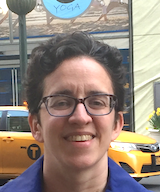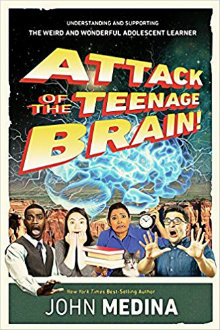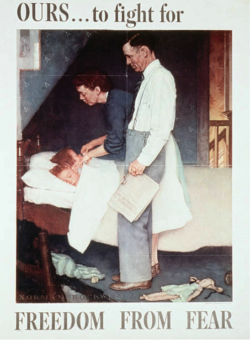Weird and Wonderful: Attack of the Teenage Brain
Attack of the Teenage Brain! Understanding and Supporting The Weird and Wonderful Adolescent Learner
By John Medina
(ASCD, 2018 – Learn more)

Have you ever stood from the sidelines and observed a group of teenagers? Social environment plays a large part in this exchange according to scientists, such as John Medina, author of “Attack of the Teenage Brain!”
It has been found that the quality of teens’ responses to choices can change simply by manipulating the demographics of the immediate social environment.

Medina asks, “Why do the shoulder devils of teenagers so often win out over the angelic counterparts?” This is all connected to the brain and how it works!
Teens, Medina notes, are into sensation seeking and this could be because the brain at this stage of development has heightened emotional reactivity. The teen brain reward center is more active than it is in younger children or adults, making teens experience rewards (and other feelings) more intensely.
Other research has shown that teens take risks with such frequency that it’s actually a leading cause of death in this age group. When it comes to risky decisions, researchers are finding that teenagers focus more on the potential for positive rewards than on negative consequences.
Medina describes an interesting experiment where researchers “looked at the association between changes in risk taking and changes in brain development.” The research included chosen subjects who were followed over time with their brains being examined at two age points; (1) before the prefrontals were hooked up to limbic structures (average age 15), and (2) after the maturation was in full swing (average age 17). At each age researchers looked at the tendency to engage in risk-taking behaviors. (Medina cautions that the study was done in a laboratory.)
The study focused on several neural modules (which Medina explains at the beginning of the book and throughout).The results show that before age 15 the VLPFC and MPFC areas of the prefrontal cortex light up to show robust activation or attraction to the risky behavior. However, at around 17 the VLPFC and MPFC deactivate showing less willingness to make a risk-taking action.
The Brain and the School
Medina uses the second half of the book to make a connection between the brain and the home and classroom environment. He asks, “What would a prospective school full of teenagers look like if we seriously addressed issues related to the executive function of the brain?“
He also explores “What would teacher training look like if it followed the same priority? It is all about relationships. These relationships start with parenting style. Then it connects to classroom life. Parents and teachers need to work together. The key to the school of the future is not technology, but these key relationships that make the child’s learning environment successful.”
Medina illustrates this point with a reflection on a painting from Norman Rockwell’s Four Freedom series which appeared on the cover of The Saturday Evening Post in 1943:
In the above image two elementary boys are asleep in their bed. Mom is hovering above them in their bed, adjusting their sheets. Dad is standing upright beside her, head down, face worn with concern. The folded newspaper symbolizes the bombing of Britain in WW II. This is just as relevant today.
One of the main predictors of a child’s academic performance is a supportive family environment. As the child gets into the teenage years, research has shown that home environment is more important than school environment for academic success. This is actually life-long because we never outgrow our need or desire to feel safe.
For those like myself who grew up watching Mister Rogers’ Neighborhood, he has left us with this message: “When I was a boy and I would see scary things in the news, my mother would say to me, ‘Look for the helpers.’ You will always find people who are helping.”
To this day, especially in times of disaster, I remember my mother’s words and I am always comforted by realizing that there are still so many helpers – so many caring people in this world. I ask myself, “Am I the Miss Rogers of my classroom?” and I ask you, are you the Mr. or Miss Rogers of your classroom? For those that are not of the Mr. Rogers generation, go check out the recent biographical movie in theaters. You missed one of the greatest childhood shows.
Parenting Styles
Medina discusses different parenting styles and the effects on a child. He also discusses successful marriage and divorce. The question asked is, “How are the parents doing?” Children’s survival is dependent on the adult parent/caretaker. Therefore, in giving his ideas for a proposed teen-brain-focused school of the future, he offers a night school annex for parents.
I did laugh for a minute. However, it is often the adults who are more of a problem than the students. Medina might get some opposition to this statement, but he says: “Most adults are woefully unprepared to rear children.” He does back it up with research though. He offers two relevant classes in his future-school model: “How to Improve your Child’s Grades by Creating a Stable Environment at Home” based on psychologist John Gottman, and “How to Become an Authoritative Parent” based on psychologist Diana Baumrind. I am asking myself, “Would this work?’
Medina himself admits designing the school of the future is no easy task. His idea for a school focused on child development research can’t happen without a complete overhaul of teacher education programs of today. Teachers themselves need to understand the underlying principles of the classroom. I ask myself, “Do I provide a safe classroom?” and “Do I enforce rules while allowing flexibility?” Medina noted most successful teachers seem to have read the right playbook, where every page is inscribed with the word “flexibility.” “Teachers recognized they are working with students and not military recruits.”
One of last chapters in the book is a current topic in school today. It focuses on social-emotional learning. Some schools are creating a class around this concept. The chapter explains key elements for successfully designing these programs. Throughout our lives, we can be overcome with emotions in difficult moments, and learning at a young age how to control these emotions is a lifelong skill.
Check out this animated video during summer break, learn John Medina’s 12 Brain Rules, and gather insights into how our brain works!
Elizabeth OBrien has worked for the Department of Education in New York City in many different teaching roles. Her main desire as an educator has been to allow children to explore and discover by giving them the right guiding tools. Her favorite quote from Albert Einstein is “The true sign of intelligence is not knowledge but imagination.”




































